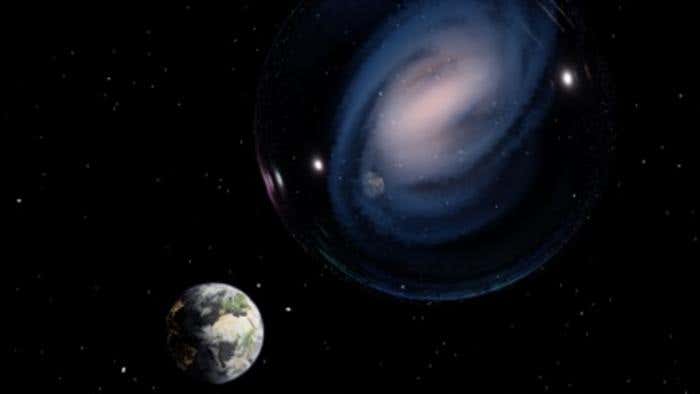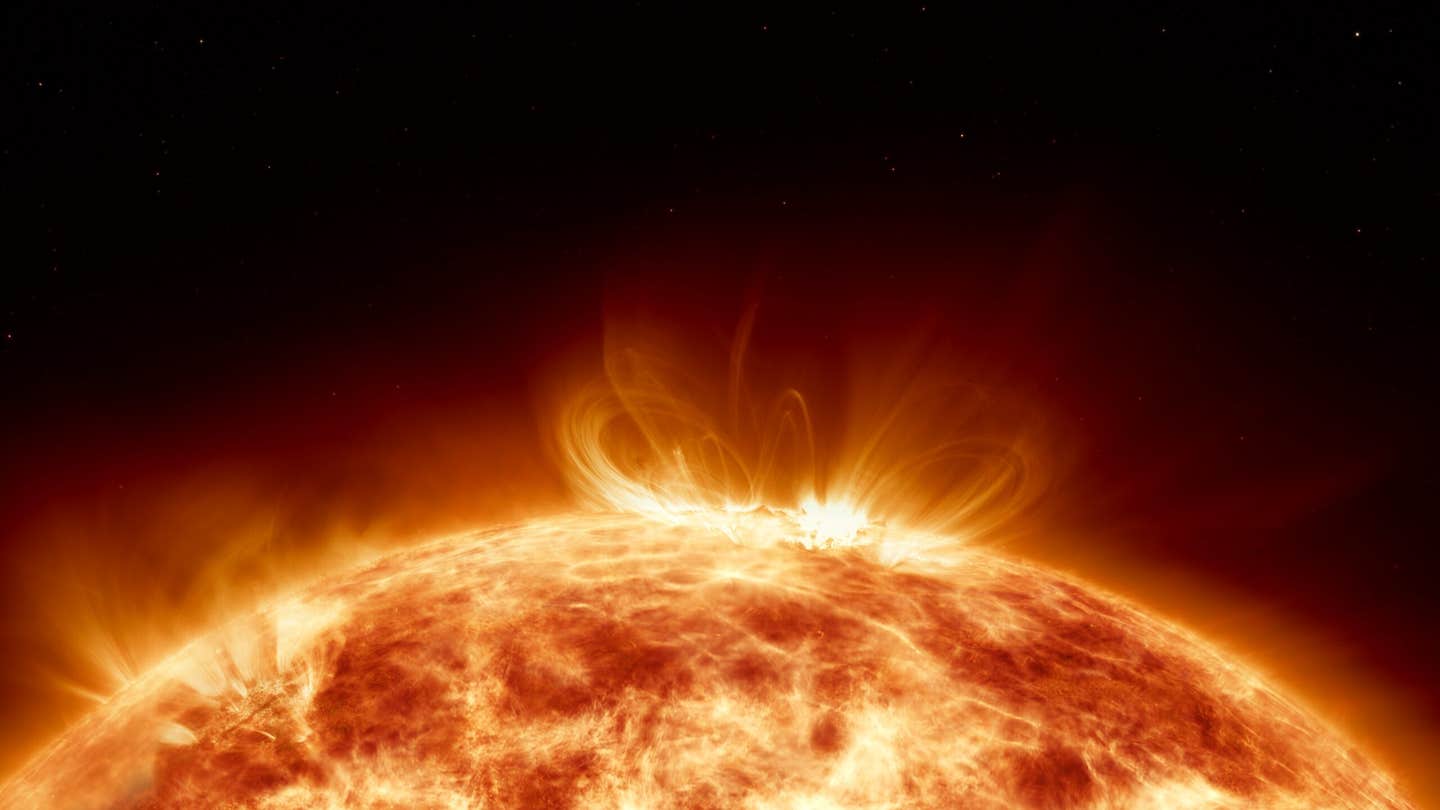Astronomers find Milky Way-like galaxy in the early universe
Researchers employed the James Webb Space Telescope to unveil the most distant barred spiral galaxy akin to our very own Milky Way.

[Nov. 12, 2023: Staff Writer, The Brighter Side of News]
Artistic representation of the spiral barred galaxy ceers-2112, observed in the early universe. The Earth is reflected on an illusive bubble surrounding the galaxy, recalling the connection between the Milky Way and ceers-2112. (CREDIT: Luca Costantin /CAB/CSIC-INTA)
In a monumental scientific breakthrough, an international team of astronomers, spearheaded by the Centro de Astrobiología in Spain, has employed the cutting-edge James Webb Space Telescope to unveil the most distant barred spiral galaxy akin to our very own Milky Way.
This astounding discovery defies previous assumptions, pushing the boundaries of our understanding of galaxy formation and evolution, while shedding light on the universe's mysterious early days.
The groundbreaking revelation, spotlighted in the prestigious journal Nature this week, is credited to the tireless efforts of astronomers worldwide. Among them is Alexander de la Vega, a prominent astronomer hailing from the University of California, Riverside, whose expertise played a pivotal role in unraveling the mysteries of this ancient celestial structure.
Up until this point, scientific consensus held that observing barred spiral galaxies resembling the Milky Way before the universe reached half of its current age, approximately 13.8 billion years old, was a nearly insurmountable challenge. However, the discovery of a galaxy christened 'ceers-2112' has defied these expectations, redefining our understanding of early universe galaxies.
Related Stories
"This galaxy, named ceers-2112, formed soon after the Big Bang," said co-author Alexander de la Vega, a postdoctoral researcher in the Department of Physics and Astronomy at the University of California, Riverside. "Finding ceers-2112 shows that galaxies in the early universe could be as ordered as the Milky Way. This is surprising because galaxies were much more chaotic in the early universe and very few had similar structures to the Milky Way."
One of the distinctive features of ceers-2112 is the presence of a galactic bar at its center, a structure composed of stars within galaxies, resembling the mundane bars we encounter in our daily lives, such as candy bars. While galactic bars are a rarity in non-spiral galaxies, they are predominantly found in their spiral counterparts.
"Nearly all bars are found in spiral galaxies," noted de la Vega, whose astronomical journey led him to UCR after completing his doctoral degree in astronomy at Johns Hopkins University. "The bar in ceers-2112 suggests that galaxies matured and became ordered much faster than we previously thought, which means some aspects of our theories of galaxy formation and evolution need revision."
Morphological modelling of ceers-2112. (CREDIT: Nature)
Traditionally, astronomers held the belief that it took several billion years for galaxies to evolve into organized structures capable of hosting bars. However, the discovery of ceers-2112 challenges this view, indicating that the formation of galactic bars can occur in a mere fraction of that time, within approximately one billion years or less.
According to de la Vega, galactic bars are thought to emerge in spiral galaxies with stars that rotate in an ordered fashion, akin to the Milky Way.
"In such galaxies, bars can form spontaneously due to instabilities in the spiral structure or gravitational effects from a neighboring galaxy," de la Vega explained. "In the past, when the universe was very young, galaxies were unstable and chaotic. It was thought that bars could not form or last long in galaxies in the early universe."
Stellar population properties of ceers-2112. (CREDIT: Nature)
The significance of the discovery of ceers-2112 extends beyond its immediate implications. It is poised to revolutionize two fundamental aspects of astronomy.
"First, theoretical models of galaxy formation and evolution will need to account for some galaxies becoming stable enough to host bars very early in the universe's history," de la Vega asserted. "These models may need to adjust how much dark matter makes up galaxies in the early universe, as dark matter is believed to affect the rate at which bars form. Second, the discovery of ceers-2112 demonstrates that structures like bars can be detected when the universe was very young. This is important because galaxies in the distant past were smaller than they are now, which makes finding bars harder. The discovery of ceers-2112 paves the way for more bars to be discovered in the young universe."
Mass-assembly history of Milky Way (MW) and M31 analogues (dashed red line), compared with ceers-2112 (yellow star). (CREDIT: Nature)
De la Vega played an instrumental role in the research team's efforts, assisting in estimating the redshift and properties of ceers-2112 and contributing valuable insights to the interpretation of their measurements.
"Redshift is an observable property of a galaxy that indicates how far away it is and how far back in time the galaxy is seen, which is a consequence of the finite speed of light," de la Vega elucidated.
What struck de la Vega as most astonishing about the discovery of ceers-2112 was the precision with which they could constrain the properties of its galactic bar.
Isophotal analysis of ceers-2112. In each panel, the shaded regions mark the size of the PSF FWHM in the different bands, while error bars show the 1σ standard deviation of each point. (CREDIT: Nature)
"Initially, I thought detecting and estimating properties of bars in galaxies like ceers-2112 would be fraught with measurement uncertainties," he confessed. "But the power of the James Webb Space Telescope and the expertise of our research team helped us place strong constraints on the size and shape of the bar."
Beyond his contributions to this groundbreaking discovery, de la Vega also dedicates his time to advancing astronomy outreach at the University of California, Riverside. He organizes telescope nights on and off campus, conducts visits to local schools for astronomy presentations, and leads the public astronomy talk series "Cosmic Thursdays," in addition to one-off events tailored to special occasions, such as viewing parties for eclipses.
The revelation of ceers-2112, the most ancient barred spiral galaxy reminiscent of the Milky Way, has sent shockwaves through the astronomical community.
This extraordinary discovery challenges conventional wisdom and opens new vistas in our understanding of galaxy formation and evolution. With the James Webb Space Telescope poised to uncover more cosmic mysteries, and astronomers like Alexander de la Vega leading the way, the cosmos continues to unravel its secrets, one celestial body at a time.
Note: Materials provided above by The Brighter Side of News. Content may be edited for style and length.
Like these kind of feel good stories? Get the Brighter Side of News' newsletter.



